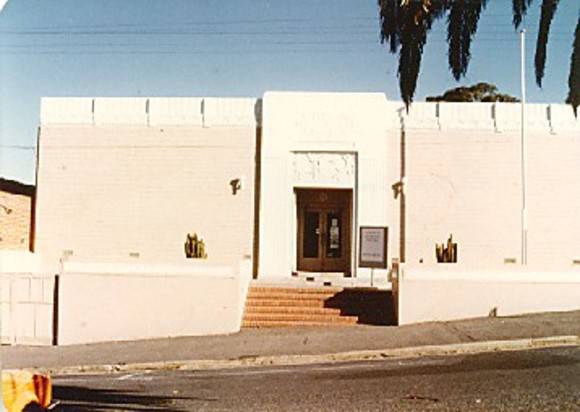| Back to search results » | Back to search page » |
|
Art Gallery - Castlemaine Historic Area
Other NameCastlemaine Art Gallery & Historic Museum Location14 Lyttleton Street,, CASTLEMAINE VIC 3450 - Property No B4668
File NumberB4668LevelState |
|
Statement of Significance
The Castlemaine Art Gallery was constructed in 1930 to a design by the architects Stephenson & Meldrum. The builder was a F. Pollerd and the contract cost 3,250 pounds. It was extended at the rear in 1960 and again in 1973. The gallery is an early example in provincial Victoria of austere Neo-Classical "modern" design. It is constructed of face brick (since painted) with rendered dressings and presents a severe facade, without windows, relieved only by the "Jazz" decorated frieze to the parapet, front garden wall and tympanum over the central entrance. The front door is recessed behind an elaborate pair of iron grille gates. The interior is lit by a ceiling lighting system under a saw-tooth roof. The interior is severely and simply decorated but with a careful control of volumes and planning in the display areas. The Castlemaine Art Gallery is an exceptional building in its intent and execution and is historically important as one of the earliest examples of the "modern movement" in provincial Victoria.
Adapted from Heritage Victoria: 08/08/2012
Classified:17/11/1983
Revised: 03/08/1998
Part of Castlemaine Historic Area B4894
Castlemaine grew as a result of the discovery of gold along Forest Creek in July, 1851. By December of that year the population on the field was greater than that of Melbourne. In 1852 Mr Templeton surveyed the township of Castlemaine and in 1853 the first action of the town site was held.
The Castlemaine goldfield was allegedly the richest alluvial goldfield in the world. Such was the prosperity of the diggers that the townsfolk were optimistically expectant of Castlemaine becoming Victoria's second city. The prosperity of the diggers and the optimistic townsfolk is reflected in the high number of imposing buildings erected in the first few years of the town's life. However, the rich alluvial diggings were worked out within 15-20 years. From the 1870's the town's population began to drift away, but they left behind a rich legacy of the town's former prosperity in the form of its buildings.
Within the Castlemaine Historic Area may be found many items of significance. These range from intact nineteenth century streetscapes composed of imposing public buildings to simple miner's cottages. Within the historic area there are a number of identifiable component areas, each telling an important part of the history of Castlemaine. In addition, there are many other items of significance outside of these areas, but still within the historic area. These include the former steam flourmill, the Church of England, the Congregational Church and Forest and Barkers Creeks.
Despite the town's topographical confinements to the valley of the two creeks, the wide streets and large buildings convey an atmosphere of grand spaciousness in this central Victorian goldfields town.
Classified: 01/12/1982
Group
Recreation and Entertainment
Category
Art Gallery/ Museum




